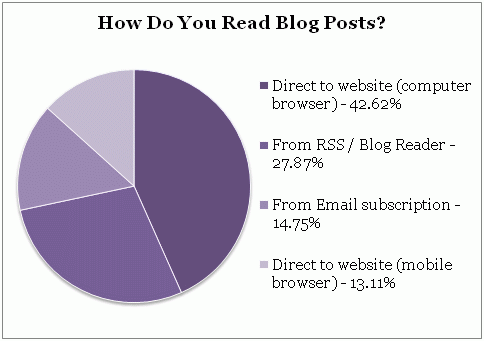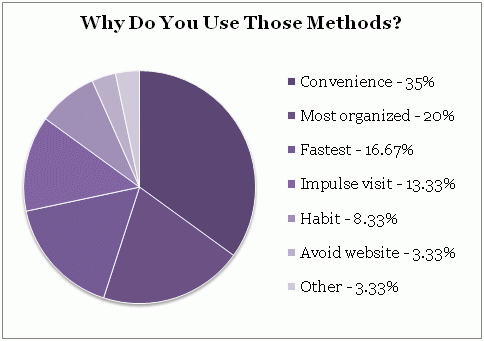Poll Answers: Part One – How People Access Blogs

First of all, huge thanks to everyone who answered my poll questions last week about how you use blogs. Hopefully, the high participation rate means the results will be helpful to all of us. In fact, due to the abundant and informative feedback in comments and tweets, I’ll be dividing my analysis into two posts.
Today’s post will focus on the results from the first two questions: How Do You Read Blog Posts and Why Do You Use Those Methods. (Reminder: People could choose their top three answers, so these categories aren’t mutually exclusive. If everyone voted for answer A and everyone voted 3 times, answer A would be 33.33%. Compare these answers to each other, not to 100%.)

The answers here surprised me. I figured the majority of people would use RSS for the organization or for having everything they wanted to read in one spot.
Why I figured this to be the case I don’t know, as I rarely use my reader anymore (the number of unread posts got too intimidating!). Apparently, I’m not the only one with that problem.
What We Can Learn: Mobile browsing is gaining in popularity fast. We put effort into making sure our blogs have an RSS feed. But according to these numbers, mobile browsing is already about half as popular as RSS feeds and that number is only going to go up. I’m definitely putting “build a mobile-specific version of my website” on my list of things to do.

No surprise here, convenience is the big winner. But “convenience” can mean different things to different people.
- One participant doesn’t own a computer, so they browse exclusively through their iPhone.
- Another found mobile browsing inconvenient because of their smartphone’s small screen size.
- Many people mentioned that they usually use an RSS blog reader but will click through to interesting links off Twitter or Facebook.
- Others limited their RSS subscriptions to their “must-see” list and used Twitter links as a filter to catch the “best of” everything else.
- Another person likes to use their website’s blog roll to organize their “go to” sites.
- I’d imagine someone who likes leaving comments would find accessing the website directly with their computer to be most convenient.
What We Can Learn: Make things as convenient as possible for our readers and don’t limit options based on our preferences. Provide our readers with RSS, email subscriptions, and mobile versions because everyone finds different things convenient.
In short, options are good and limitations are bad. Several people complained about blogs that have RSS feeds limited to a teaser paragraph, which you then have to click through to read the rest. Yes, it might be tempting to force people to visit your website but don’t do it.
Final Thoughts and Lessons Learned: I think the blogs that get the most readers are the ones that see themselves as offering a service. If we think of our readers as customers, we won’t make things harder for them. We’ll cater to their needs where it makes sense for our branding or goals.
Despite this, we shouldn’t be afraid of creating interactive content on our blog because it might not work with RSS. As the results of the first question revealed, the most popular method for visiting a blog is still going directly to the website with a computer browser.
This is a good thing. At the website, people are more likely to leave comments and join a conversation, as well as interact by watching video or participating in polls. If our content is good enough, people will visit our blogs and become a participant in the community we’re creating.
What do you think of my analysis? Did you come away with other interpretations? Can you think of any reasons to limit our content (either with teaser feeds or avoiding interactive elements)?

Great information and I look forward to putting this knowledge to use. Thanks for always making me think!!
Hi Rachel,
Thanks! Yeah, this was dangerous for me – thinking about numbers? 🙂 Glad I could add some perspective.
Thanks Jami! I’ve often wondered about how many use the RSS feeders. And you’re really on to something when you cater to your readers wants and needs. Good job!
waiting for part 2…
Hi J.A.,
Thanks once again for giving me the idea for the poll! 🙂
This is actually fascinating – thanks for aggregating it so neatly! Honestly, I really thought most people probably read through RSS or some sort of subscription – I’ve heard from several people that they read my posts on their phone or email first thing in the morning, rather than visiting the blog. Mine might shake out a little differently though, since I have the serial novel going as well. That doesn’t really invite comment/interaction so much as just give people something to read. I get a lot of hits from twitter too, depending on the post.
Thanks for stopping by mine this morning – I saw links to your posts “somewhere” yesterday, and meant to drop by then, but forgot. Your comment reminded me…you’re in my reader now. 🙂
Hi Jamie,
Thanks for the comment! Yes, I was surprised as well, and I’m sure different blogs might get different results, but since I didn’t ask specifically in relation to my blog, I hope the answers are helpful to everyone.
Hi, Jami. I’m a couple days late commenting. I read my subscribed blogs from Google Reader. It’s right on my home page when I open my browser so they’re all organized and in one place. If I want to comment, I’ll open the blog. I don’t subscribe to a lot of blogs, otherwise I’d spend a squizzillion hours a day reading them.
But the majority of the blog posts I read are those I link to from interesting Tweets–that’s how I found you. And I’ve read so many of your blog posts that now I am subscribing!
Hi Clara,
Great to see you here! Thanks for the comment, and I understand. Even with using Twitter to filter the most interesting links, I still spend way too much time reading them all. 🙂
I thought most would use the RSS feed, too. lol But I have one and rarely use it, so the number of unread posts is huge. Huge! HUGE!!! So I don’t use it anymore. I guess a lot of people ran into that.
Hi Sonia,
Yep, my problem exactly. When I see thousands of unread posts, I tend to hang it up and give up. 🙂
[…] part one, we talked about how to help your blog readers find you. And in part two, we discussed the things that turn off from visiting blogs. Down in the […]
[…] last post highlighted ways a blog can serve its readership. This post focuses on what not to do when […]
[…] be wasted if we include elements that make people want to avoid our blog, or if we don’t keep different access methods or readers who are disabled in […]